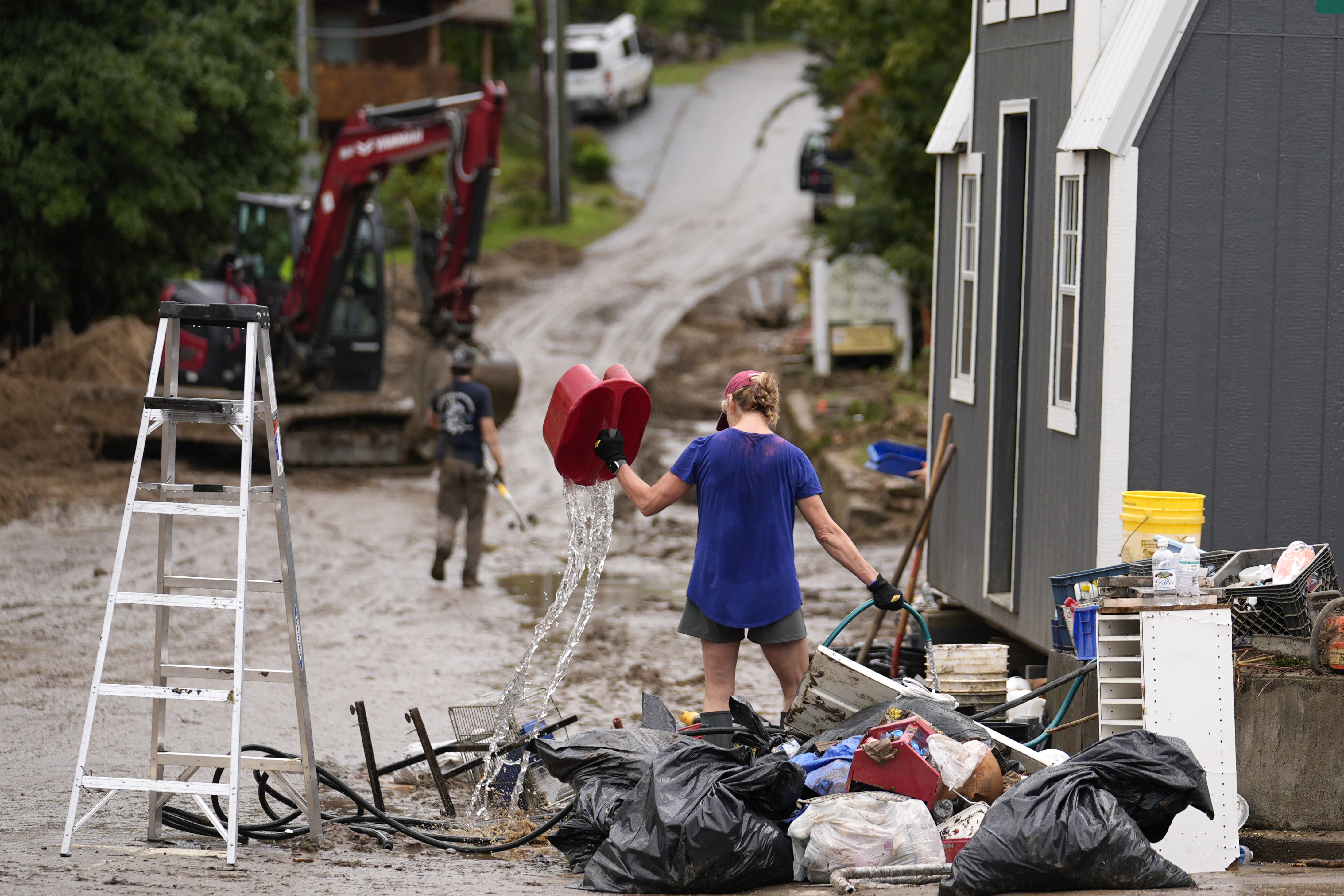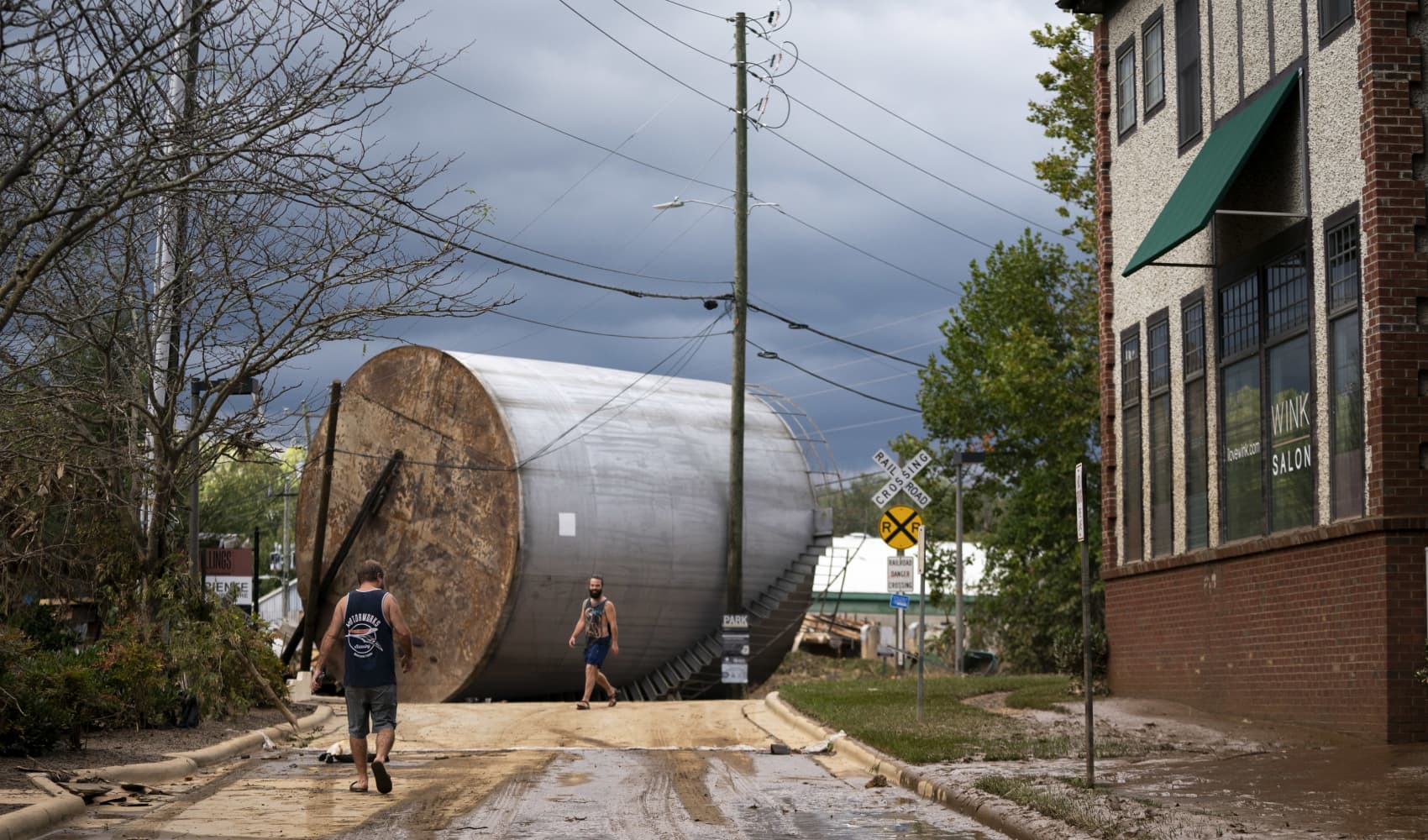President Joe Biden surveyed the devastation in North and South Carolina on Wednesday as rescuers continued their search for anyone still unaccounted for after Hurricane Helene caused catastrophic damage across the Southeast and killed at least 190 people.
Biden flew over toppled trees, twisted metal and towering piles of debris in the normally tourist friendly downtown of Asheville, North Carolina, on Wednesday, as he took a tour by helicopter of Hurricane Helene 's path of destruction. At the same time, Vice President Kamala Harris was getting her own look at the storm's damage in Georgia.
Many highways in the hardest-hit parts of North Carolina remained inaccessible, but from his Marine One helicopter, Biden saw flooded roads, piles of shredded lumber and displaced sandbags, emergency trucks and downed power lines. In one area, homes were partly under water, and it was hard to distinguish between lake and land. Nearly 200 miles to the south, Harris was in Augusta, where she sat for a briefing and thanked assembled officials for helping “meet the needs of people who must be seen and must be heard.”
“I am now listening,” Harris said.
Get top local stories in Philly delivered to you every morning. Sign up for NBC Philadelphia's News Headlines newsletter.
The role was familiar for Biden, who has frequently been called on to survey damage and console victims after tornadoes, wildfires, tropical storms and other natural disasters. But it's less so for Harris until now, as she vies to succeed him as president. Both are also seeking to demonstrate a larger commitment and competence in helping devastated communities after Donald Trump’s false claims about their administration’s response.
Before leaving for the helicopter tour, Biden wore a vest and boots and hugged and grabbed the hand of Asheville Mayor Esther Manheimer who was at the airport in Greenville, South Carolina, to meet him. The White House announced during his flight that he’d also be visiting storm damaged parts of Florida and Georgia on Thursday.
Manheimer noted that they could not close down the area’s one operable road for Biden’s motorcade. The White House said Harris had also spoken to the mayor and was planning her own trip to North Carolina in coming days.
Before leaving Washington, Biden made a point of mentioning how an ongoing dockworkers strike could make getting supplies to hard-hit areas more difficult.
“Natural disasters are incredibly consequential. The last thing we need on top of that is a man-made disaster that’s going on at the ports,” the president said. “We’re getting pushback already, we’re hearing from the folks regionally that they’re having trouble getting product that they need because of the port strike.”
Harris' trip, meanwhile, presented an additional political test in the midst of a humanitarian crisis. She's trying to step into a role for which Biden is well known — showing the empathy that Americans expect in times of tragedy — in the closing stretch of her White House campaign.
The vice president last visited scenes of natural disasters as a California senator, including when she went to Puerto Rico after Hurricane Maria in 2017 and when she walked through charred wreckage in Paradise, California, after the Camp Fire in 2018.
Julie Chavez Rodriguez, Harris’ campaign manager and former state director in her Senate office, said the vice president uses her experience consoling victims as a courtroom prosecutor to connect with people after tragedies.
She said the trip to Georgia was a chance for Harris "to continue to show her leadership and her ability to get things done, versus Donald Trump and JD Vance who want to dismantle the basic services and the role that the government should play.”
Trump, the Republican nominee, traveled to Valdosta, Georgia, on Monday with a Christian charity organization that brought trucks of fuel, food, water and other supplies. The former president accused Biden of “sleeping” and not responding to calls from Georgia Republican Gov. Brian Kemp. However, Kemp had spoken with Biden the previous day, and the governor said the state was getting everything it needed.
Biden was infuriated by Trump’s claim, saying Trump was “lying, and the governor told him he was lying.”
The White House said that as many as 1,000 active-duty soldiers, part of an Infantry Battalion Task Force based out of Fort Liberty, North Carolina, will begin work helping to deliver food, fuel and supplies in the region.
“Even before Hurricane Helene hit, I directed my team to do everything possible to prepare to support communities in the storm’s path,” Biden said in a statement. “I mobilized the entire Federal government to bring every possible resource to the fight to save lives and help those in urgent need.”
The death toll climbed to at least 190 people, and power and cellular service remained unavailable in some places.
Trump claimed without evidence that Democratic leaders were withholding help from Republican areas, an accusation that better describes his own approach to disaster relief. He recently threatened that he would withhold wildfire assistance from California because of disagreements with Democratic Gov. Gavin Newsom.
When Trump was president, Puerto Rico was devastated by Hurricane Maria, which killed 3,000 people. His administration waited until the fall of 2020, just weeks before the presidential election, to release $13 billion in assistance for Puerto Rico’s recovery. A federal government watchdog also found that Trump administration officials hampered an investigation into delays in the aid delivery.
During a visit there, he was criticized for tossing paper towel rolls to survivors at a relief center. The gesture seemed to go over well in the room but was widely panned as insensitive to those who were suffering. He also questioned whether the death toll was accurate, claiming it rose “like magic.”
Harris visited Puerto Rico after Maria as part of a bipartisan delegation.
“When disaster hits anywhere in America, our government has a basic responsibility to commit the resources necessary to save lives, accurately assess damage, and rebuild communities," she wrote on Twitter in 2018. "We now know that after Hurricane Maria, our government failed Puerto Rico at every level.”
Last month, on the seventh anniversary of Maria, Harris recalled speaking with Puerto Ricans who had lost businesses and homes.
“They didn’t need paper towels thrown at them — they needed real help and partnership,” she said.
What is being done to help?
Exhausted emergency crews worked around the clock to clear roads, restore power and phone service, and reach those still stranded by the storm, which killed at least 183 people in six states, including many who were hit by falling trees or trapped in flooded cars and homes. Nearly half of the deaths were in North Carolina, while dozens of others were in South Carolina and Georgia.
More than 150,000 households have registered for assistance with the Federal Emergency Management Agency, and that number is expected to rise rapidly in the coming days, said Frank Matranga, an agency representative.
Nearly 2 million ready-to-eat meals and more than a million liters of water have been sent to the hardest-hit areas, he said.
The storm unleashed the worst flooding in a century in North Carolina, dumping more than 2 feet (61 centimeters) of rain in places.
Cooper’s administration said Tuesday that more than two dozen water plants remained closed. Active-duty U.S. military units may be needed to assist the long-term recovery, he said, adding that Biden had given “the green light” to mobilizing military assets soon.
A section of one of the region’s main arteries, Interstate 40, reopened Tuesday after a mudslide was cleared, but a collapsed stretch near North Carolina’s border with Tennessee remained closed.
How some of the hardest-hit areas are coping
Residents and business owners wore masks and gloves while clearing debris Tuesday in Hot Springs, North Carolina, where almost every building along the tiny town’s main street was heavily damaged.
Sarah Calloway, who owns the deli and gourmet grocery Vaste Riviere Provisions, said the storm arrived in town frighteningly quickly. She helped fill sandbags the day the night before, but they turned out to be useless. The water rose so rapidly that even though she and others were in an apartment on an upper floor, she feared they would not be safe. They called to request a rescue from a swift water team.
“They tried to get to us, and at that point they couldn’t,” she said. “Luckily, that was when the water started to recede.”
“It was really challenging to watch how quickly it rose up and then just to watch whole buildings floating down the river. It was something I can’t even describe,” she said.
In pictures: See damage from Hurricane Helene
In the Black Mountain Mobile Home Park in Swannanoa on Tuesday, Carina Ramos and Ezekiel Bianchi were overwhelmed by the damage. The couple, their children and dog fled in the predawn darkness on Friday as the Swannanoa River’s rapidly rising waters began flooding the bottom end of the park.
By then, trees were blocking the roads and the couple abandoned their three vehicles, all of which flooded.
“We left everything because we were panicking,” Ramos said.
Their children were staying with Ramos’ parents and did not want to even see the devastated trailer.
“My daughter was crying, panicking,” Ramos said. “She says she doesn’t want to see her room full of toys, all thrown everywhere.”
Mobile service knocked out
The widespread damage and outages affecting communications infrastructure left many people without stable access to the internet and cellular service.
Mayor Zeb Smathers of Canton, North Carolina, expressed frustration Tuesday that so many of his constituents were still without cell service and given no clear timetable for when it would be restored.
“People are walking the streets of Canton with their phones up in the air trying to catch a cellphone signal like it’s a butterfly,” he told The Associated Press. “Every single aspect of this response has been extremely crippled by lack of cellphone communication. The one time we absolutely needed our cellphones to work they failed.”
Teams from Verizon were working to repair downed cell towers, damaged fiber cables and provide alternative forms of connectivity across the region, the company said in a statement.
AT&T, meanwhile, said it launched “one of the largest mobilizations of our disaster recovery assets for emergency connectivity support.”
The efforts to restore service was made more challenging by the region’s terrain and spread-out population, said David Zumwalt, president and CEO of the Association for Broadband Without Boundaries.
Destruction from Florida to Virginia
Helene blew ashore in Florida late Thursday as a Category 4 hurricane and upended life throughout the Southeast, where deaths were also reported in Florida, Tennessee and Virginia.
Across Georgia, Helene’s inland path knocked out power and shattered lives from Valdosta to Augusta, where a line of cars waiting to get water Tuesday stretched at least a half-mile (0.8 kilometers) down the road.
“It’s been rough,” said Kristie Nelson, who had no idea when her electricity would be restored. “I’m just dying for a hot shower.”
With at least 36 killed in South Carolina, Helene passed the 35 people who were killed in the state after Hurricane Hugo made landfall north of Charleston in 1989.
When Tennessee Gov. Lee flew to the eastern part of the state to survey damage on Tuesday, residents said the governor and his entourage were the first help they had seen since the storm hit.
“Where has everyone been?" one frustrated local asked. "We have been here alone."
___
Kruesi reported from Hampton, Tennessee. Contributing to this report were Associated Press journalists Gary D. Robertson in Raleigh; Jeffrey Collins in Augusta, Georgia; John Raby in Charleston, West Virginia; Rebecca Santana in New Orleans; Shawn Chen in New York; Colleen Long in Washington and John Seewer in Toledo, Ohio.



